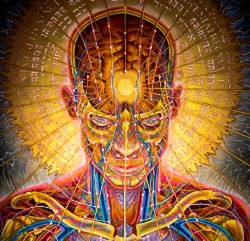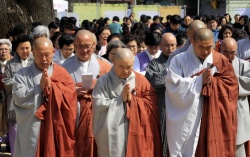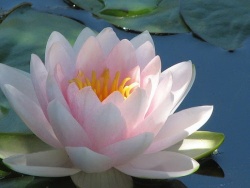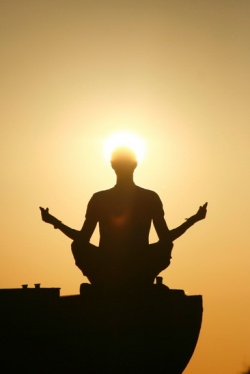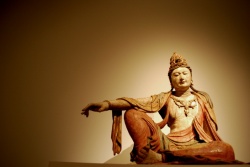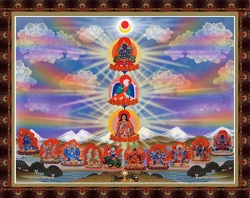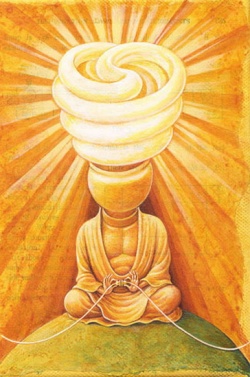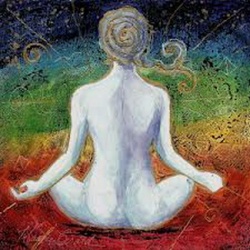Difference between revisions of "Kenshō"
m (Text replacement - "benefiting others" to "benefiting others") |
|||
| Line 1: | Line 1: | ||
[[File:Ment1of1.jpg|thumb|250px|]] | [[File:Ment1of1.jpg|thumb|250px|]] | ||
| + | |||
| + | |||
| + | |||
| + | |||
| + | |||
[[Kenshō]] {{Wiki|traditional Chinese}}: [[見性]]; [[Japanese]]: [[見性]]; literally: "[[see one's nature]]") is a [[Japanese]] term from the [[Zen]] [[tradition]]. [[Ken]] means "[[seeing]]," [[shō]] means "{{Wiki|nature}}," "[[essence]]. | [[Kenshō]] {{Wiki|traditional Chinese}}: [[見性]]; [[Japanese]]: [[見性]]; literally: "[[see one's nature]]") is a [[Japanese]] term from the [[Zen]] [[tradition]]. [[Ken]] means "[[seeing]]," [[shō]] means "{{Wiki|nature}}," "[[essence]]. | ||
| + | |||
| + | ‘[[Seeing]] into one’s [[own]] [[nature]]’, the goal of [[Zen practice]]. The first [[experience]] of [[Satori]] | ||
| + | (q.v.). | ||
[[Kenshō]] is an initial [[insight]] or [[awakening]], not full [[Buddhahood]]. It is to be followed by further {{Wiki|training}} to deepen this [[insight]], and learn to express it in daily [[life]]. | [[Kenshō]] is an initial [[insight]] or [[awakening]], not full [[Buddhahood]]. It is to be followed by further {{Wiki|training}} to deepen this [[insight]], and learn to express it in daily [[life]]. | ||
| Line 37: | Line 45: | ||
The {{Wiki|Modern}} Standard {{Wiki|Chinese}} pronunciation [[jianxing]] historically derives from (c. 7th century CE) Middle {{Wiki|Chinese}} kienCsjäŋC. | The {{Wiki|Modern}} Standard {{Wiki|Chinese}} pronunciation [[jianxing]] historically derives from (c. 7th century CE) Middle {{Wiki|Chinese}} kienCsjäŋC. | ||
| − | {{Wiki|East Asian}} [[Languages]], particularly the Sino-Xenic [[Japanese]], [[Korean]], and [[Vietnamese]] tongues, borrowed the {{Wiki|Chinese}} [[Buddhist]] term jianxing as a loanword: | + | {{Wiki|East Asian}} [[Languages]], particularly the Sino-Xenic [[Japanese]], [[Korean]], and [[Vietnamese]] tongues, borrowed the {{Wiki|Chinese}} [[Buddhist]] term [[jianxing]] as a loanword: |
[[File:Apan-earthquake.jpg|thumb|250px|]] | [[File:Apan-earthquake.jpg|thumb|250px|]] | ||
| − | * [[kenshō]] [[見性]] or [[ケンショウ]] ([[on'yomi]]) in Sino-Japanese vocabulary, | + | * [[kenshō]] [[見性]] or [[ケンショウ]] ([[on'yomi]]) in [[Sino-Japanese]] vocabulary, |
* [[kyŏnsŏng]] (McCune-Reischauer) [[견성]] in Sino-Korean vocabulary, | * [[kyŏnsŏng]] (McCune-Reischauer) [[견성]] in Sino-Korean vocabulary, | ||
* [[kiến tính]] in Sino-Vietnamese vocabulary. | * [[kiến tính]] in Sino-Vietnamese vocabulary. | ||
| Line 58: | Line 66: | ||
| − | * [[Soothill]] (1934): "To behold the [[Buddha-nature]] within oneself, a common saying of the [[Chan]] ([[Zen]]) or Intuitive School." | + | * [[Soothill]] (1934): "To behold the [[Buddha-nature]] within oneself, a common saying of the [[Chan]] ([[Zen]]) or [[Intuitive School]]." |
| − | * Fischer-Schreiber (1991): Lit. "[[seeing]] {{Wiki|nature}}"; [[Zen]] expression for the [[experience]] of [[awakening]] ([[enlightenment]]). Since the [[meaning]] is "[[seeing]] one's own [[true nature]]," [[kenshō]] is usually translated "[[self-realization]]." Like all words that try to reduce the conceptually ungraspable [[experience]] of [[enlightenment]] to a {{Wiki|concept}}, this one is also not entirely accurate and is even misleading, since the [[experience]] contains no [[duality]] of "[[seer]]" and "seen" because there is no "{{Wiki|nature}} of [[self]]' as an [[object]] that is seen by a [[subject]] separate from it. | + | * Fischer-Schreiber (1991): Lit. "[[seeing]] {{Wiki|nature}}"; [[Zen]] expression for the [[experience]] of [[awakening]] ([[enlightenment]]). Since the [[meaning]] is "[[seeing]] one's [[own]] [[true nature]]," [[kenshō]] is usually translated "[[self-realization]]." Like all words that try to reduce the conceptually ungraspable [[experience]] of [[enlightenment]] to a {{Wiki|concept}}, this one is also not entirely accurate and is even misleading, since the [[experience]] contains no [[duality]] of "[[seer]]" and "seen" because there is no "{{Wiki|nature}} of [[self]]' as an [[object]] that is seen by a [[subject]] separate from it. |
| − | * [[Baroni]] (2002): "[[Seeing]] one's {{Wiki|nature}}," that is, [[realizing]] one's own original [[Buddha Nature]]. [[Kenshō]] is a [[Japanese]] term commonly used for an [[enlightenment]] [[experience]]; in many cases, it is used synonymously with [[satori]]. In the [[Rinzai school]], it most often refers more specifically to one's initial [[enlightenment]] [[experience]] [[attained]] though [[kôan]] practice. | + | * [[Baroni]] (2002): "[[Seeing]] one's {{Wiki|nature}}," that is, [[realizing]] one's [[own]] original [[Buddha Nature]]. [[Kenshō]] is a [[Japanese]] term commonly used for an [[enlightenment]] [[experience]]; in many cases, it is used synonymously with [[satori]]. In the [[Rinzai school]], it most often refers more specifically to one's initial [[enlightenment]] [[experience]] [[attained]] though [[kôan]] practice. |
| − | * Muller (year unknown): To see one's own originally [[enlightened]] [[mind]]. To behold the [[Buddha-nature]] within oneself, a common saying of the [[Chan]] school, as seen for example, in the [[phrase]] '[[seeing]] one's {{Wiki|nature}}, becoming [[Buddha]]' [[見性成佛]]. | + | * Muller (year unknown): To see one's [[own]] originally [[enlightened]] [[mind]]. To behold the [[Buddha-nature]] within oneself, a common saying of the [[Chan]] school, as seen for example, in the [[phrase]] '[[seeing]] one's {{Wiki|nature}}, becoming [[Buddha]]' [[見性成佛]]. |
| Line 75: | Line 83: | ||
* [[D.T. Suzuki]]: "Looking into one's {{Wiki|nature}} or the opening of [[satori]]"; "This acquiring of a new point of [[view]] in our dealings with [[life]] and the [[world]] is popularly called by [[Japanese]] [[Zen]] students '[[satori]]' (wu in {{Wiki|Chinese}}). It is really another [[name]] for [[Enlightenment]] ([[Annuttara-samyak-sambodhi]])". | * [[D.T. Suzuki]]: "Looking into one's {{Wiki|nature}} or the opening of [[satori]]"; "This acquiring of a new point of [[view]] in our dealings with [[life]] and the [[world]] is popularly called by [[Japanese]] [[Zen]] students '[[satori]]' (wu in {{Wiki|Chinese}}). It is really another [[name]] for [[Enlightenment]] ([[Annuttara-samyak-sambodhi]])". | ||
| − | * [[Dumoulin]] (1988/2005): "[[Enlightenment]] is described here as an [[insight]] into the [[identity]] of one's own {{Wiki|nature}} with all of [[reality]] in an [[eternal]] now, as a [[vision]] that removes all {{Wiki|distinctions}}. This [[enlightenment]] is the center and the goal of the [[Zen]] way. [[Hakuin]] prefers the term "[[seeing]] into one's {{Wiki|nature}}", which for him means [[ultimate reality]]. The [[Buddha nature]] and the [[cosmic]] [[Buddha]] [[body]], [[wisdom]] ([[prajna]]), and [[emptiness]] ([[sunyata]]), the original countenance one had before one was born, and other {{Wiki|expressions}} from the rich palette of [[Mahayana]] terms were all familiair to him from his continued study of the [[sutras]] and [[Zen]] {{Wiki|literature}}." | + | * [[Dumoulin]] (1988/2005): "[[Enlightenment]] is described here as an [[insight]] into the [[identity]] of one's [[own]] {{Wiki|nature}} with all of [[reality]] in an [[eternal]] now, as a [[vision]] that removes all {{Wiki|distinctions}}. This [[enlightenment]] is the center and the goal of the [[Zen]] way. [[Hakuin]] prefers the term "[[seeing]] into one's {{Wiki|nature}}", which for him means [[ultimate reality]]. The [[Buddha nature]] and the [[cosmic]] [[Buddha]] [[body]], [[wisdom]] ([[prajna]]), and [[emptiness]] ([[sunyata]]), the original [[countenance]] one had before one was born, and other {{Wiki|expressions}} from the rich palette of [[Mahayana]] terms were all familiair to him from his continued study of the [[sutras]] and [[Zen]] {{Wiki|literature}}." |
| − | * [[Peter Harvey]] (1990): "It is a blissful [[realization]] where a person's inner {{Wiki|nature}}, the originally [[pure mind]], is directly known as an [[illuminating]] [[emptiness]], a [[thusness]] which is dynamic and immanent in the [[world]]." | + | * [[Peter Harvey]] (1990): "It is a [[blissful]] [[realization]] where a person's inner {{Wiki|nature}}, the originally [[pure mind]], is directly known as an [[illuminating]] [[emptiness]], a [[thusness]] which is dynamic and immanent in the [[world]]." |
| − | * [[G. Victor Sogen Hori]] (2000): "The term consists of two characters: ken, which means "see" or "[[seeing]]", and [[sho]], which means "{{Wiki|nature}}", "[[character]]", "quality." To "see one's {{Wiki|nature}}" is the usual translation for [[kensho]]". | + | * [[G. Victor Sogen Hori]] (2000): "The term consists of two characters: ken, which means "see" or "[[seeing]]", and [[sho]], which means "{{Wiki|nature}}", "[[character]]", "[[quality]]." To "see one's {{Wiki|nature}}" is the usual translation for [[kensho]]". |
| Line 88: | Line 96: | ||
| − | * [[Jiyu-Kennett]]: "To see into one's own {{Wiki|nature}}. The [[experience]] of [[enlightenment]], [[satori]]." | + | * [[Jiyu-Kennett]]: "To see into one's [[own]] {{Wiki|nature}}. The [[experience]] of [[enlightenment]], [[satori]]." |
* [[Myodo Ni Satomi]], a [[student]] of [[Hakuun Yasutani]] (1993): "[[Seeing]] the-self, that is, the [[true self]] or [[Buddha nature]]." | * [[Myodo Ni Satomi]], a [[student]] of [[Hakuun Yasutani]] (1993): "[[Seeing]] the-self, that is, the [[true self]] or [[Buddha nature]]." | ||
| Line 121: | Line 129: | ||
The notion of "[[experience]]" has been criticized. [[Robert Sharf]] points out that "[[experience]]" is a typical {{Wiki|western}} term, which has found it's way into {{Wiki|Asian}} religiosity via {{Wiki|western}} [[influences]]. The notion of "[[experience]]" introduces a false notion of [[duality]] between "[[experiencer]]" and "[[experienced]]", where-as the [[essence]] of [[kensho]] is the {{Wiki|realisation}} of the "[[non-duality]]" of observer and observed. "[[Pure experience]]" does not [[exist]]; all [[experience]] is mediated by [[intellectual]] and [[cognitive]] [[activity]]. The specific teachings and practices of a specific [[tradition]] may even determine what "[[experience]]" someone has, which means that this "[[experience]]" is not the [[proof]] of the [[teaching]], but a result of the [[teaching]]. | The notion of "[[experience]]" has been criticized. [[Robert Sharf]] points out that "[[experience]]" is a typical {{Wiki|western}} term, which has found it's way into {{Wiki|Asian}} religiosity via {{Wiki|western}} [[influences]]. The notion of "[[experience]]" introduces a false notion of [[duality]] between "[[experiencer]]" and "[[experienced]]", where-as the [[essence]] of [[kensho]] is the {{Wiki|realisation}} of the "[[non-duality]]" of observer and observed. "[[Pure experience]]" does not [[exist]]; all [[experience]] is mediated by [[intellectual]] and [[cognitive]] [[activity]]. The specific teachings and practices of a specific [[tradition]] may even determine what "[[experience]]" someone has, which means that this "[[experience]]" is not the [[proof]] of the [[teaching]], but a result of the [[teaching]]. | ||
| − | A [[pure consciousness]] without [[Wikipedia:concept|concepts]], reached by "cleaning the doors of [[perception]]", would be an overwhelming {{Wiki|chaos}} of sensory input without coherence. The notion of "[[experience]]" also over-emphasises [[kensho]], as if it were the single goal of [[Zen]]-{{Wiki|training}}, where-as the [[Zen-tradition]] clearly states that "the stink of [[Zen]]" has to be removed and the "[[experience]]" of [[kensho]] has to be integrated into daily [[life]]. In the [[Rinzai-school]] this post-[[satori]] {{Wiki|training}} includes the study and mastering of great amounts of [[classical Chinese poetry]], which is far from "[[universal]]" and culture-transcending. On the contrary, it demands an [[education]] in culture-specific [[language]] and {{Wiki|behaviour}}, which is measured by specific and strict {{Wiki|cultural}} norms. Emphasising "[[experience]]" "reduces the sophisticated [[dialectic]] of [[Ch'an]]/[[Zen]] [[doctrine]] and praxis to a mere "means" or set of techniques intended to inculate such [[experiences]]". | + | A [[pure consciousness]] without [[Wikipedia:concept|concepts]], reached by "cleaning the doors of [[perception]]", would be an overwhelming {{Wiki|chaos}} of sensory input without coherence. The notion of "[[experience]]" also over-emphasises [[kensho]], as if it were the single goal of [[Zen]]-{{Wiki|training}}, where-as the [[Zen-tradition]] clearly states that "the stink of [[Zen]]" has to be removed and the "[[experience]]" of [[kensho]] has to be integrated into daily [[life]]. In the [[Rinzai-school]] this post-[[satori]] {{Wiki|training}} includes the study and mastering of great amounts of [[classical Chinese poetry]], which is far from "[[universal]]" and culture-transcending. On the contrary, it demands an [[education]] in culture-specific [[language]] and {{Wiki|behaviour}}, which is measured by specific and strict {{Wiki|cultural}} norms. Emphasising "[[experience]]" "reduces the sophisticated [[dialectic]] of [[Ch'an]]/[[Zen]] [[doctrine]] and praxis to a mere "means" or set of [[techniques]] intended to inculate such [[experiences]]". |
| Line 158: | Line 166: | ||
| − | : At [[Nanzenji]] there is a small hill. I used to walk near there, look at it, and often [[smile]] at the high school students who walked by there as well. One day as I walked by, I looked at the hill and it was truly amazing. i was totally lost as if there was no 'me'. I stood gazing at the hill. Some students walked by and one of them said something like 'look at that crazy [[monk]]'. Finally I came out of it. [[Life]] was never the same for me. I was free. | + | : At [[Nanzenji]] there is a small [[hill]]. I used to walk near there, look at it, and often [[smile]] at the high school students who walked by there as well. One day as I walked by, I looked at the [[hill]] and it was truly amazing. i was totally lost as if there was no 'me'. I stood gazing at the [[hill]]. Some students walked by and one of them said something like 'look at that crazy [[monk]]'. Finally I came out of it. [[Life]] was never the same for me. I was free. |
| Line 169: | Line 177: | ||
[[Kenshō]] may be [[attained]] without the aid of a [[teacher]]. For example [[Richard Clarke]] (1933), who studied with [[Philip Kapleau]], states that he had a spontaneous [[kensho]] when he was 13. [[Dennis Genpo Merzel]] states he had what he described as an "[[awakening]] [[experience]]" in 1971: | [[Kenshō]] may be [[attained]] without the aid of a [[teacher]]. For example [[Richard Clarke]] (1933), who studied with [[Philip Kapleau]], states that he had a spontaneous [[kensho]] when he was 13. [[Dennis Genpo Merzel]] states he had what he described as an "[[awakening]] [[experience]]" in 1971: | ||
| − | : It was in February of that year, and I was 26 years old. My second serious relationship was ending, and I was [[feeling]] very confined and conflicted. I needed to get some [[space]], so I went out to the [[Mojave desert]] for a three-day camping weekend with two friends. On the Friday, I hiked up a mountain alone. I knew [[nothing]] about [[meditation]] or [[spiritual practice]]. I was just sitting there, [[thinking]] about my [[life]] and the things going on. I felt I had gotten pretty screwed up for such a young age. | + | : It was in February of that year, and I was 26 years old. My second serious relationship was ending, and I was [[feeling]] very confined and conflicted. I needed to get some [[space]], so I went out to the [[Mojave desert]] for a three-day camping weekend with two friends. On the [[Friday]], I hiked up a mountain alone. I knew [[nothing]] about [[meditation]] or [[spiritual practice]]. I was just sitting there, [[thinking]] about my [[life]] and the things going on. I felt I had gotten pretty screwed up for such a young age. |
| − | : I could see my VW camper, my home for the weekend, parked a few {{Wiki|miles}} away, . But at the same [[time]], I was {{Wiki|aware}} that my home was back in Long Beach, {{Wiki|California}}. And a natural [[koan]] came to me: Where is home? All of a sudden, I had a kind of breakthrough. I felt myself fall away, and I became one with the [[cosmos]], one with the [[universe]], one with all things. I knew in that moment that wherever I am, that is home; home is everywhere. I also knew who I was, [[beyond]] description, but let’s call it Big [[Mind]]. | + | : I could see my VW camper, my home for the weekend, parked a few {{Wiki|miles}} away, . But at the same [[time]], I was {{Wiki|aware}} that my home was back in Long Beach, {{Wiki|California}}. And a natural [[koan]] came to me: Where is home? All of a sudden, I had a kind of [[breakthrough]]. I felt myself fall away, and I became one with the [[cosmos]], one with the [[universe]], one with all things. I knew in that [[moment]] that wherever I am, that is home; home is everywhere. I also knew who I was, [[beyond]] description, but let’s call it Big [[Mind]]. |
: That [[experience]] completely changed my [[life]]. | : That [[experience]] completely changed my [[life]]. | ||
| Line 185: | Line 193: | ||
According to Harris, working towards [[kensho]] is usually a lengthy process stretched out over years or even decades. Contrary to this, [[Victor Hori]] notes that with [[koan]]-study [[kensho]] may appear within six months. | According to Harris, working towards [[kensho]] is usually a lengthy process stretched out over years or even decades. Contrary to this, [[Victor Hori]] notes that with [[koan]]-study [[kensho]] may appear within six months. | ||
| − | [[Sōtō]] tends towards a [[gradual]] approach, preferring to let the [[experiences]] happen on their own. [[Rinzai]] tends toward the use of [[Koans]] as a technique to unroot the habitual workings of the [[mind]]. | + | [[Sōtō]] tends towards a [[gradual]] approach, preferring to let the [[experiences]] happen on their [[own]]. [[Rinzai]] tends toward the use of [[Koans]] as a technique to unroot the habitual workings of the [[mind]]. |
During intensive [[zazen]] various [[hallucinations]] and [[psychological]] {{Wiki|disturbances}} may arise. These are referred to as [[makyo]]. Distinguishing these [[delusions]] from actual [[kensho]] is the [[primary]] [[function]] of the [[teacher]], as the [[student]] may be erroneously convinced they have [[realized]] [[kensho]]. | During intensive [[zazen]] various [[hallucinations]] and [[psychological]] {{Wiki|disturbances}} may arise. These are referred to as [[makyo]]. Distinguishing these [[delusions]] from actual [[kensho]] is the [[primary]] [[function]] of the [[teacher]], as the [[student]] may be erroneously convinced they have [[realized]] [[kensho]]. | ||
| Line 196: | Line 204: | ||
| − | : At some point in [[time]] we pass from imprisonment in [[ignorance]] and [[delusion]] to a true [[vision]] of [[Zen realization]]: "Our [[enlightenment]] is timeless, yet our [[realization]] of it occurs in [[time]]." According to this [[belief]] experiencing a moment of [[awakening]] in this [[life]] is of {{Wiki|central}} importance. | + | : At some point in [[time]] we pass from imprisonment in [[ignorance]] and [[delusion]] to a true [[vision]] of [[Zen realization]]: "Our [[enlightenment]] is timeless, yet our [[realization]] of it occurs in [[time]]." According to this [[belief]] experiencing a [[moment]] of [[awakening]] in this [[life]] is of {{Wiki|central}} importance. |
| − | In the [[Rinzai]]-{{Wiki|training}}, the [[student]] is expected to pour oneself totally in both [[koan]]-study and daily [[activities]] 'to become one' with it. [[Kenshō]] is used to describe the first breakthrough in [[kōan]] study. | + | In the [[Rinzai]]-{{Wiki|training}}, the [[student]] is expected to pour oneself totally in both [[koan]]-study and daily [[activities]] 'to become one' with it. [[Kenshō]] is used to describe the first [[breakthrough]] in [[kōan]] study. |
| Line 210: | Line 218: | ||
[[File:R Preiss.jpg|thumb|250px|]] | [[File:R Preiss.jpg|thumb|250px|]] | ||
| − | : According to the [[tradition]] of [[Soto]] [[Zen]], although working on a [[koan]] is one way of [[attaining]] [[kensho]], the best way is [[zazen]]. Indeed, [[Dogen]], the founder of [[Soto Zen]], expounded that [[zazen]] itself is [[enlightenment]], and as long as the {{Wiki|adept}} maintains a [[pure]] state of non-thinking in [[Zen]], he is a [[Buddha]]. | + | : According to the [[tradition]] of [[Soto]] [[Zen]], although working on a [[koan]] is one way of [[attaining]] [[kensho]], the best way is [[zazen]]. Indeed, [[Dogen]], the founder of [[Soto Zen]], expounded that [[zazen]] itself is [[enlightenment]], and as long as the {{Wiki|adept}} maintains a [[pure]] [[state]] of non-thinking in [[Zen]], he is a [[Buddha]]. |
| Line 216: | Line 224: | ||
| − | [[Kenshō]] also plays a {{Wiki|central}} in the [[Sanbō Kyōdan]], a [[Japanese]] [[Zen]]-organisation which played a decisive role in the [[transmission]] of [[Zen]] to the [[United States]]. [[Yasutani]], the founder of the [[Sanbo Kyodan]], was disappointed about the lack of [[interest]] in [[kensho]] in the [[Soto-school]]. [[Yasutani's]] {{Wiki|emphasis}} on [[koan]]-{{Wiki|training}} and the importance of [[kensho]] was transmitted to his American students: | + | [[Kenshō]] also plays a {{Wiki|central}} in the [[Sanbō Kyōdan]], a [[Japanese]] [[Zen]]-organisation which played a decisive role in the [[transmission]] of [[Zen]] to the [[United States]]. [[Yasutani]], the founder of the [[Sanbo Kyodan]], was disappointed about the lack of [[interest]] in [[kensho]] in the [[Soto-school]]. [[Yasutani's]] {{Wiki|emphasis}} on [[koan]]-{{Wiki|training}} and the importance of [[kensho]] was transmitted to his [[American]] students: |
| Line 265: | Line 273: | ||
| − | Though the literal [[meaning]] is [[self-awakened]], or [[awakened]] on one's own, the {{Wiki|emphasis}} in [[Zen]], when using these terms, lies in the [[ultimate]] reliance on one's own [[insight]], instead of the authority of a [[teacher]]: | + | Though the literal [[meaning]] is [[self-awakened]], or [[awakened]] on one's [[own]], the {{Wiki|emphasis}} in [[Zen]], when using these terms, lies in the [[ultimate]] reliance on one's [[own]] [[insight]], instead of the authority of a [[teacher]]: |
[[File:Images7588.jpg|thumb|250px|]] | [[File:Images7588.jpg|thumb|250px|]] | ||
| Line 289: | Line 297: | ||
{{see}}[[Dzogchen]] | {{see}}[[Dzogchen]] | ||
| − | The [[Dzogchen]]-[[traditions]] states that the [[Wikipedia:Absolute (philosophy)|ultimate]] [[nature]] of all [[sentient beings]] is [[pure]], all-encompassing, [[primordial awareness]], or naturally occurring timeless [[awareness]]. This intrinsic [[awareness]] has no [[form]] of its own, and yet is capable of perceiving, experiencing, {{Wiki|reflecting}}, or expressing all [[form]]. It does so without {{Wiki|being}} affected by those [[forms]] in any [[ultimate]], [[permanent]] way. | + | The [[Dzogchen]]-[[traditions]] states that the [[Wikipedia:Absolute (philosophy)|ultimate]] [[nature]] of all [[sentient beings]] is [[pure]], all-encompassing, [[primordial awareness]], or naturally occurring timeless [[awareness]]. This intrinsic [[awareness]] has no [[form]] of its [[own]], and yet is capable of perceiving, experiencing, {{Wiki|reflecting}}, or expressing all [[form]]. It does so without {{Wiki|being}} affected by those [[forms]] in any [[ultimate]], [[permanent]] way. |
| − | The {{Wiki|analogy}} given by [[Dzogchen]] [[masters]] is that one's {{Wiki|nature}} is like a [[mirror]] which reflects with complete [[openness]], but is not affected by the reflections. [[Rigpa]] is the [[knowledge]] that ensues from [[recognizing]] this mirror-like clarity, which cannot be found by searching nor identified. One [[knows]] that there is a [[primordial]] freedom from [[grasping]] his or her [[mind]]. | + | The {{Wiki|analogy}} given by [[Dzogchen]] [[masters]] is that one's {{Wiki|nature}} is like a [[mirror]] which reflects with complete [[openness]], but is not affected by the reflections. [[Rigpa]] is the [[knowledge]] that ensues from [[recognizing]] this [[mirror-like clarity]], which cannot be found by searching nor identified. One [[knows]] that there is a [[primordial]] freedom from [[grasping]] his or her [[mind]]. |
| Line 297: | Line 305: | ||
| − | In {{Wiki|Advaita Vedanta}} [[moksha]] is [[attained]] by [[jnana]], insight-knowledge. In [[Shankara's]] [[philosophical]] {{Wiki|synthesis}} [[insight]] [[samadhi]] is used as a subsidiary to this goal. [[Swami Vivekananda]] emphasized the [[experience]] of [[nirvikalpa samadhi]] as a means to validate [[religious]], [[transcendental knowledge]]. | + | In {{Wiki|Advaita Vedanta}} [[moksha]] is [[attained]] by [[jnana]], [[insight-knowledge]]. In [[Shankara's]] [[philosophical]] {{Wiki|synthesis}} [[insight]] [[samadhi]] is used as a subsidiary to this goal. [[Swami Vivekananda]] emphasized the [[experience]] of [[nirvikalpa samadhi]] as a means to validate [[religious]], [[transcendental knowledge]]. |
{{W}} | {{W}} | ||
Latest revision as of 09:58, 23 November 2020
Kenshō traditional Chinese: 見性; Japanese: 見性; literally: "see one's nature") is a Japanese term from the Zen tradition. Ken means "seeing," shō means "nature," "essence.
‘Seeing into one’s own nature’, the goal of Zen practice. The first experience of Satori (q.v.).
Kenshō is an initial insight or awakening, not full Buddhahood. It is to be followed by further training to deepen this insight, and learn to express it in daily life.
The term kenshō is often used interchangeably with satori, which is derived from the verb satoru, and means "comprehension; understanding".
Terminology
The Chinese Buddhist term jianxing (simplified Chinese: 见性; traditional Chinese: 見性; pinyin: jiànxìng; Wade–Giles: chien-hsing) compounds:
- jian 見 "see, observe, meet with, perceive";
- xing 性 "(inborn) nature, character, personality, disposition, property, quality,gender".
History
Buddhist monks who produced Sanskrit-Chinese translations of sutras faced many linguistic difficulties:
- They chose Chinese jian 見 to translate Sanskrit dṛś दृश् "see, look", and the central Buddhist idea of dṛṣṭi दृष्टि "view, seeing (also with the mind's eye), wisdom, false view".
- Translators used xing 性 or zixing 自性 "self-nature" for Sanskrit svabhāva स्वभाव "intrinsic nature, essential nature".
Thus, jianxing was the translation for dṛṣṭi-svabhāva, "view one's essential nature".
The (c. 8th century) Chinese Platform Sutra (2, Prajñā "wisdom, understanding") first records jianxing.
Pronunciations
The Modern Standard Chinese pronunciation jianxing historically derives from (c. 7th century CE) Middle Chinese kienCsjäŋC.
East Asian Languages, particularly the Sino-Xenic Japanese, Korean, and Vietnamese tongues, borrowed the Chinese Buddhist term jianxing as a loanword:
- kenshō 見性 or ケンショウ (on'yomi) in Sino-Japanese vocabulary,
- kyŏnsŏng (McCune-Reischauer) 견성 in Sino-Korean vocabulary,
- kiến tính in Sino-Vietnamese vocabulary.
Meanings of kenshō
- See also: Bodhi, Prajna, Buddha-nature, Sunyata, Suchness, Dharmakaya, and Alayavijnana
Translating kenshō into English is semantically complex.
Encyclopedic and dictionary defintions
Some encyclopedia and dictionary definitions are:
- Soothill (1934): "To behold the Buddha-nature within oneself, a common saying of the Chan (Zen) or Intuitive School."
- Fischer-Schreiber (1991): Lit. "seeing nature"; Zen expression for the experience of awakening (enlightenment). Since the meaning is "seeing one's own true nature," kenshō is usually translated "self-realization." Like all words that try to reduce the conceptually ungraspable experience of enlightenment to a concept, this one is also not entirely accurate and is even misleading, since the experience contains no duality of "seer" and "seen" because there is no "nature of self' as an object that is seen by a subject separate from it.
- Baroni (2002): "Seeing one's nature," that is, realizing one's own original Buddha Nature. Kenshō is a Japanese term commonly used for an enlightenment experience; in many cases, it is used synonymously with satori. In the Rinzai school, it most often refers more specifically to one's initial enlightenment experience attained though kôan practice.
- Muller (year unknown): To see one's own originally enlightened mind. To behold the Buddha-nature within oneself, a common saying of the Chan school, as seen for example, in the phrase 'seeing one's nature, becoming Buddha' 見性成佛.
Definitions by Buddhist scholars
Buddhist scholars have defined kenshō as:
- D.T. Suzuki: "Looking into one's nature or the opening of satori"; "This acquiring of a new point of view in our dealings with life and the world is popularly called by Japanese Zen students 'satori' (wu in Chinese). It is really another name for Enlightenment (Annuttara-samyak-sambodhi)".
- Dumoulin (1988/2005): "Enlightenment is described here as an insight into the identity of one's own nature with all of reality in an eternal now, as a vision that removes all distinctions. This enlightenment is the center and the goal of the Zen way. Hakuin prefers the term "seeing into one's nature", which for him means ultimate reality. The Buddha nature and the cosmic Buddha body, wisdom (prajna), and emptiness (sunyata), the original countenance one had before one was born, and other expressions from the rich palette of Mahayana terms were all familiair to him from his continued study of the sutras and Zen literature."
- Peter Harvey (1990): "It is a blissful realization where a person's inner nature, the originally pure mind, is directly known as an illuminating emptiness, a thusness which is dynamic and immanent in the world."
- G. Victor Sogen Hori (2000): "The term consists of two characters: ken, which means "see" or "seeing", and sho, which means "nature", "character", "quality." To "see one's nature" is the usual translation for kensho".
Definitions by Buddhist teachers and practitioners
Buddhist teachers and practitioners have defined kenshō as:
- Jiyu-Kennett: "To see into one's own nature. The experience of enlightenment, satori."
- Myodo Ni Satomi, a student of Hakuun Yasutani (1993): "Seeing the-self, that is, the true self or Buddha nature."
Further notions
The term kenshō refers to the realization of nonduality of subject and object in general, but the term kenshō may also be applied in other contexts: "How do you kenshō this?"
Kenshō is not a single experience, but refers to a whole series of realizations from a beginner's shallow glimpse of the nature of mind, up to a vision of emptiness equivalent to the 'Path of Seeing' or to Buddhahood itself. In all of these, the same 'thing' is known, but in different degrees of clarity and profundity.
"Kenshō" is commonly translated as enlightenment, a word that is also used to translate bodhi, prajna, satori and buddhahood. Western discourse tends to use these terms interchangeably, but there is a distinction between a first insight, and the further development toward Buddhahood.
Insight versus experience
- See also: Buddhist modernism
Kensho is insight, an understanding of reality as-it-is. Contemporary understanding also describes kensho as an experience. The term "enlightenment experience" is itself a tautology: "Kensho is a kensho-experience".
The notion of "experience" fits in a popular set of dichotomies: pure (unmediated) versus mediated, noncognitive versus cognitive, experiential versus intellectual, intuitive versus intellectual, nonrational versus rational, nondiscursive versus discursive, nonpropositional versus propositional.
The notion of pure experience (junsui kuiken) to interpret and understand kensho was introduced by Nishida Kitaro in his An Inquiry into the Good (1911), under influence of "his somewhat idiosyncratic reading of western philosophy", especially William James, who wrote The Varieties of Religious Experience. Wayne Proudfoot traces the roots of the notion of "religious experience" to the German theologian Friedrich Schleiermacher (1768-1834), who argued that religion is based on a feeling of the infinite. The notion of "religious experience" was used by Schleiermacher to defend religion against the growing scientific and secular critique. It was adopted by many scholars of religion, of which William James was the most influential. D.T. Suzuki, who introduced Nishida Kitaro to western philosophy, took over this notion of pure experience, describing it as the essence of all religions, but best represented in the superior Japanese culture and religion.
The influence of western psychology and philosophy on Japanese Buddhism was due to the persecution of Buddhism at the beginning of the Meiji Restoration, and the subsequent efforts to construct a New Buddhism (shin bukkyo), adapted to the modern times. It was this New Buddhism which has shaped the understanding of Zen in the west, especially through the writings of D.T. Suzuki and the Sanbo Kyodan, an exponent of the Meiji-era opening of Zen-training for lay-followers.
The notion of "experience" has been criticized. Robert Sharf points out that "experience" is a typical western term, which has found it's way into Asian religiosity via western influences. The notion of "experience" introduces a false notion of duality between "experiencer" and "experienced", where-as the essence of kensho is the realisation of the "non-duality" of observer and observed. "Pure experience" does not exist; all experience is mediated by intellectual and cognitive activity. The specific teachings and practices of a specific tradition may even determine what "experience" someone has, which means that this "experience" is not the proof of the teaching, but a result of the teaching.
A pure consciousness without concepts, reached by "cleaning the doors of perception", would be an overwhelming chaos of sensory input without coherence. The notion of "experience" also over-emphasises kensho, as if it were the single goal of Zen-training, where-as the Zen-tradition clearly states that "the stink of Zen" has to be removed and the "experience" of kensho has to be integrated into daily life. In the Rinzai-school this post-satori training includes the study and mastering of great amounts of classical Chinese poetry, which is far from "universal" and culture-transcending. On the contrary, it demands an education in culture-specific language and behaviour, which is measured by specific and strict cultural norms. Emphasising "experience" "reduces the sophisticated dialectic of Ch'an/Zen doctrine and praxis to a mere "means" or set of techniques intended to inculate such experiences".
Kenshō "experiences"
Classical accounts
The classical Zen-texts, such as the Kao-seng-chuan (Biographies of Eminent Monks) and the transmission lists, called "Transmission of the Lamp"; the yü-lü genre (the recorded sayings of the masters, such as the Linji yü lü); and the various koan-collections, contain accounts of "enlightenment experiences". These accounts are not verbatim recordings of such "experiences", but well-edited texts, written down decennia or even decades after the supposed sayings and meetings.
The Denkōroku, "The Record of the Transmission of the Light", written by Keizan Jōkin 瑩山紹瑾 (1268–1325), is an example of the "Transmission of the Lamp"-genre. It contains literary accounts of the patriarchs of the Soto-lineage, from Shakyamuni Buddha to Koun Ejō, in which kensho plays a central role. They are not to be taken as literal accounts of awakening, but as stories underpinning the legitimacy of the Dogen-shu, which in its early history had seen a fierce internal conflict over the correct lineage during the Sandai sōron.
The Denkoroku gives the following account of Dogen's awakening:
- Once, during late-night zazen, Rujing told the monks, "Studying Zen is the dropping off of body and mind." Hearing this, the master was suddenly greatly awakened. He went at once to the abott's room and burned incense. Rujing asked him, "Why are you burning incense?" The master answered, "Body and mind have dropped off." Rujing said, "Body and mind have dropped off, the dropped-off body and mind." The master said, "This is a temporarily ability; you must not approve me without reason." Rujing replied, "I am not approving you without reason." The master asked, "Why are you not approving me without reason?" Rujing said, "You dropped off body and mind." The master bowed. Rujing said, "You have dropped off dropping off."
Contemporary accounts
Although the Zen tradition is reluctant to speak openly about the 'experience' of kensho, personal accounts can be found in Zen-texts.
Hakuin gives this description of his first kensho, when he was 21:
- At around midnight on the seventh and final night of my practice, the boom of a bell from a distant temple reached my ears: suddenly, my my body and mind dropped completely away. I rose clear of even the finest dust. Overwhelmed with joy, I hollowed out at the tops of my lungs, "Old Yen-t'ou is alive and well! [...] After that, however, I became extremely proud and arrogant".
Hakuin's kensho was not approved by Shoju Rojin, who subjected Hakuin to more koan-training. This resulted in a second kensho, where-after Hakuin left Shoju Rojin. It was only when he was 41 that he attained "his final great enlightenment":
- [W]hen Shoju had asked his reason for becoming a monk, his reply - that he had done it because he was afraid of falling into hell - had brought the scornful retort: "You're a self-centered rascal, aren't you!" Not until eighteen years later, upon attainment of his final great enlightenment at the age of forty-one, would Hakuin fully grasp the significance of Shoju's reproach and with it the true meaning of "post-satori" practice. Years later, when Hakuin asked his student Torei the same question, Torei's answer - "To work for the salvation of my fellow beings" - brought a laugh from Hakuin. "A much better reason than mine", he said.
Keido Fukushima, a 20th century Rinzai abbott, gives the following description:
- At Nanzenji there is a small hill. I used to walk near there, look at it, and often smile at the high school students who walked by there as well. One day as I walked by, I looked at the hill and it was truly amazing. i was totally lost as if there was no 'me'. I stood gazing at the hill. Some students walked by and one of them said something like 'look at that crazy monk'. Finally I came out of it. Life was never the same for me. I was free.
Other accounts can be found throughout the Zen-literature.
Spontaneous kenshō
Kenshō may be attained without the aid of a teacher. For example Richard Clarke (1933), who studied with Philip Kapleau, states that he had a spontaneous kensho when he was 13. Dennis Genpo Merzel states he had what he described as an "awakening experience" in 1971:
- It was in February of that year, and I was 26 years old. My second serious relationship was ending, and I was feeling very confined and conflicted. I needed to get some space, so I went out to the Mojave desert for a three-day camping weekend with two friends. On the Friday, I hiked up a mountain alone. I knew nothing about meditation or spiritual practice. I was just sitting there, thinking about my life and the things going on. I felt I had gotten pretty screwed up for such a young age.
- I could see my VW camper, my home for the weekend, parked a few miles away, . But at the same time, I was aware that my home was back in Long Beach, California. And a natural koan came to me: Where is home? All of a sudden, I had a kind of breakthrough. I felt myself fall away, and I became one with the cosmos, one with the universe, one with all things. I knew in that moment that wherever I am, that is home; home is everywhere. I also knew who I was, beyond description, but let’s call it Big Mind.
- That experience completely changed my life.
More descriptions of "spontaneous kensho" can be found throughout the Zen-literature.
Training towards kenshō
- See also:Zen practice
According to Harris, working towards kensho is usually a lengthy process stretched out over years or even decades. Contrary to this, Victor Hori notes that with koan-study kensho may appear within six months.
Sōtō tends towards a gradual approach, preferring to let the experiences happen on their own. Rinzai tends toward the use of Koans as a technique to unroot the habitual workings of the mind.
During intensive zazen various hallucinations and psychological disturbances may arise. These are referred to as makyo. Distinguishing these delusions from actual kensho is the primary function of the teacher, as the student may be erroneously convinced they have realized kensho.
Rinzai
In the Rinzai school, kensho is seen as indispensable:
- At some point in time we pass from imprisonment in ignorance and delusion to a true vision of Zen realization: "Our enlightenment is timeless, yet our realization of it occurs in time." According to this belief experiencing a moment of awakening in this life is of central importance.
In the Rinzai-training, the student is expected to pour oneself totally in both koan-study and daily activities 'to become one' with it. Kenshō is used to describe the first breakthrough in kōan study.
Sōtō
In the Sōtō school there are two kinds of awakening. One is the practice of shikantaza, which is the "actual enlightened activity of the Buddha". The other is the accumulation of little bits of understanding, which come together, giving way to a deeper intuitive knowledge.
The "genjo-koan", or the "koan of everyday life" which "appears naturally in daily life", is emphasized. Students are not encouraged to actively seek out kenshō experiences. In Sōtō practice kenshōs "are allowed to occur naturally, as a by-product of practice. Meditative training is seen as the unfolding of one great kenshō:
- According to the tradition of Soto Zen, although working on a koan is one way of attaining kensho, the best way is zazen. Indeed, Dogen, the founder of Soto Zen, expounded that zazen itself is enlightenment, and as long as the adept maintains a pure state of non-thinking in Zen, he is a Buddha.
Sanbō Kyōdan
Kenshō also plays a central in the Sanbō Kyōdan, a Japanese Zen-organisation which played a decisive role in the transmission of Zen to the United States. Yasutani, the founder of the Sanbo Kyodan, was disappointed about the lack of interest in kensho in the Soto-school. Yasutani's emphasis on koan-training and the importance of kensho was transmitted to his American students:
- He was especially vocal concerning the point of kenshō, seeing one's true nature. He spoke more openly about it then anyone of his times, going so far as to have a public acknowledgement of those who had experienced kensho in a post-sesshin ceremony of bowing in gratitude to the three treasures.
It is also reflected in the inclusion of a relative great amount of kensho-stories in "The three pillars of Zen", written by Philip Kapleau, a student of Yasutani.
Training after kenshō
- See also:Bodhicitta and Karuṇā
Zen Buddhist training does not end with kenshō. Practice is to be continued to deepen the insight and to express it in daily life.
According to Hakuin, the main aim of "post-satori practice" (gogo no shugyo, or kojo, "going beyond") is to cultivate the "Mind of Enlightenment", "benefiting others by giving them the gift of the Dharma teaching". According to Yamada Koun, "if you cannot weep with a person who is crying, there is no kensho".
But one also has to purify oneself by ongoing practice. And "experience" has to be supplemented by intellectual understanding and study of the buddhist teachings; otherwise one remains a zen temma, a "Zen devil". Finally, these efforts are to result in a natural, effortless, down-to-earth state of being, the "ultimate liberation", "knowing without any kind of defilement".
To deepen the initial insight of kensho, shikantaza and kōan-study are necessary. This trajectory of initial insight followed by a gradual deepening and ripening is expressed by Linji Yixuan in his Three mysterious Gates, the Four Ways of Knowing of Hakuin, and the Ten Ox-Herding Pictures which detail the steps on the Path.
This gradual cultivation is described by contemporary Chan Master Sheng Yen as follows:
- Ch'an expressions refer to enlightenment as "seeing your self-nature". But even this is not enough. After seeing your self-nature, you need to deepen your experience even further and bring it into maturation. You should have enlightenment experience again and again and support them with continuous practice. Even though Ch'an says that at the time of enlightenment, your outlook is the same as of the Buddha, you are not yet a full Buddha.
The contemporary western Rev. Master Jiyu-Kennett also underscored the need of further practice:
- One can easily get the impression that realization, kenshō, an experience of enlightenment, or however you wish to phrase it, is the end of Zen training. It is not. It is, rather, a new beginning, an entrance into a more mature phase of Buddhist training. To take it as an ending, and to "dine out" on such an experience without doing the training that will deepen and extend it, is one of the greatest tragedies of which I know. There must be continuous development, otherwise you will be as a wooden statue sitting upon a plinth to be dusted, and the life of Buddha will not increase.
Sudden insight
- See also:Subitism
Kenshō is described as appearing suddenly, upon an interaction with someone else, at hearing or reading some significant phrase, or at the perceiving of an unexpected sound or sight. The idea of "sudden insight" has been hotly debated in the history of Zen. It became part of the Traditional Zen Narrative in the 8th century.
Chinul, a 12th-century Korean Seon master, emphasized that insight into our true nature is sudden, but is to be followed by practice to ripen the insight and attain full Buddhahood. The contemporary Korean Seon master Seongcheol opposed this, emphasizing "sudden enlightenment, sudden cultivation". But Jiyu-Kennett, a contemporary western teacher, warns that attaining kenshō does not mean that a person is free from morality, the laws of karma, or the consequences of ones actions. This warning is reflected in the Wild fox koan.
Mushi-dokugo andmushi-dokkaku
- See also:Mushi-dokugo
Kenshō may be attained without the aid of a teacher, as in the case of mushi-dokugo or (mushi-)dokkaku, a self-awakened pratyeka-buddha.
Though the literal meaning is self-awakened, or awakened on one's own, the emphasis in Zen, when using these terms, lies in the ultimate reliance on one's own insight, instead of the authority of a teacher:
- It is awakening that is one's true master. With Shakyamuni, the awakening was his master. In other words, the awakened self is one's master. Apart from getting awakened to that master, there is no awakening. Here practitioner and master are of one body, not two. Instead of having another verify or confirm one's awakening, one does so for oneself. Of course in this case the self that is verified and the master who does verification are undivided. In their being completely identical is the autonomous, independent, or ultimate nature of the authenticity.
Similarities with other traditions
While the Japanese term "kenshō" is generally used by practitioners of Zen Buddhism, the insight it refers to is not limited to Japanese Zen Buddhism, or even to Buddhism in general.
Theravada
]] The Theravada tradition, which is best known in the west through the modern Vipassana movement, discerns four stages of enlightenment, in which Nirvana is being reached in four succeeding sudden steps of insight.
Dzogchen
- See also:Dzogchen
The Dzogchen-traditions states that the ultimate nature of all sentient beings is pure, all-encompassing, primordial awareness, or naturally occurring timeless awareness. This intrinsic awareness has no form of its own, and yet is capable of perceiving, experiencing, reflecting, or expressing all form. It does so without being affected by those forms in any ultimate, permanent way.
The analogy given by Dzogchen masters is that one's nature is like a mirror which reflects with complete openness, but is not affected by the reflections. Rigpa is the knowledge that ensues from recognizing this mirror-like clarity, which cannot be found by searching nor identified. One knows that there is a primordial freedom from grasping his or her mind.
Advaita Vedanta
In Advaita Vedanta moksha is attained by jnana, insight-knowledge. In Shankara's philosophical synthesis insight samadhi is used as a subsidiary to this goal. Swami Vivekananda emphasized the experience of nirvikalpa samadhi as a means to validate religious, transcendental knowledge.
